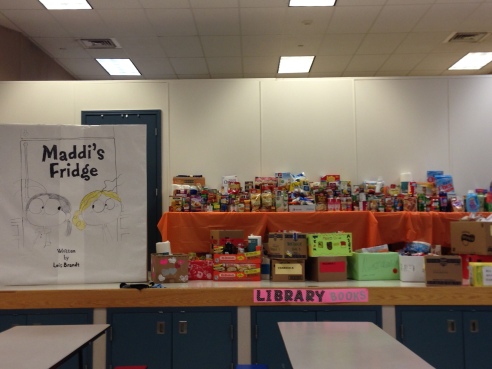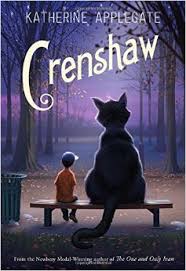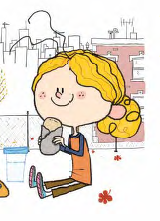A few weeks ago I visited an elementary school in northern Washington State.
The school held a food drive and collected 1600 food items before my visit.
I spoke to three assemblies and then led two writers’ workshops. At the beginning of 5th grade workshop, I asked the kids if they had questions about Maddi’s Fridge that didn’t get answered at the assembly.
One girl shot her hand up straight in the air. “Why don’t you do a second book, this time tell Maddi’s story.” What she meant was, tell Maddi’s Fridge from Maddi’s point of view.
I answered her by suggesting the class read Crenshaw by Katherine Applegate, a middle grade novel told from the point of view of a boy who has an empty refrigerator.
I went on to the next question. The girl’s hand went straight up back in the air. After answering a few questions I called on her again.
“What I’m asking is, why don’t you write Maddi’s story?”
The reason I love school visits, the reason I love to teach, is that I am given so much more than I bring when I walk into a school. I am given the gift of looking at the world in new and thoughtful ways.
The girl was asking me why Maddi didn’t have a direct voice in her story.
At this point I need to back up and let you know that the school I visited, the school that brought in 1600 food items for their local food bank, has a school-wide Title 1 program. In this school 29% of the kids come from families that earn less than $24,000 a year for a family of 4. An additional 11% of the kids are in families that earned less than $44,000 a year for a family of 4. (If you wonder how such a student body could bring in so many food items, read my blog post “What if the Poor Aren’t Stupid.”)
Many children in that school were already familiar with a grim statistic. Over half of American children are raised in families living below the poverty level. Some of the kids I was speaking with were living with empty refrigerators and empty cupboards.
Why didn’t I write Maddi’s story from her point of view? Why was Maddi’s story told by Sofia, a girl who had plenty of food in her refrigerator?
The simple answer is that I wrote a story based on my own experiences. I was an observer of a horrific event, the indifference our prosperous county pays to the hungry children in our midst. My childhood anguish when I found out that my best friend’s family had no food was still paramount in my mind as I wrote Maddi’s Fridge years later. I wrote from my point of view.
But what about Maddi?
There has been a lot of discussion in the KidLit community about diversity in children’s books. Maddi’s Fridge has been mentioned frequently as a diverse book because it has a character living in poverty. (Remember, that’s now 51% of our children.)
But Sofia tells the story. Is that right?
What a difficult and complex question.
Maddi’s Fridge is my first book and I wanted to, was driven to, tell that story through my own eyes.
However, one story is not enough. There are 12.5 MILLION stories of childhood hunger happening right now in the United States. Why aren’t these stories showing up in the books we are reading. Not just books about hunger, but mysteries, sci fi, romance, adventure, fantasy, etc. Why are some groups so hidden from our collective consciousness? Why are so many children underrepresented in the books we read? Not only as characters, but also as viewpoint characters?
That fifth grade girl was telling me that she wasn’t in Maddi’s Fridge. Yes, she felt a connection with the book, but what about the Maddis of the world? Don’t they have the right to tell their own stories?
I am very proud of Maddi’s Fridge. It pushed into an area that was rarely explored by picture books and has touched the hearts of thousands of children and adults.
But that young girl’s question was a reminder to me, a reminder to all of us who write stories, to pay attention to the stories we tell. Who have we hidden? What voices have we unwittingly silenced?


